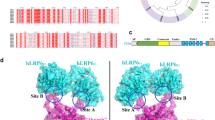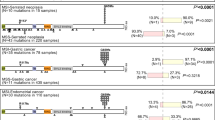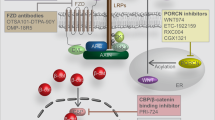Abstract
Constitutive activation of Wnt/β-catenin signaling in cancer results from mutations in pathway components, which frequently coexist with autocrine Wnt signaling or epigenetic silencing of extracellular Wnt antagonists. Among the extracellular Wnt inhibitors, the secreted frizzled-related proteins (SFRPs) are decoy receptors that contain soluble Wnt-binding frizzled domains. In addition to SFRPs, other endogenous molecules harboring frizzled motifs bind to and inhibit Wnt signaling. One of such molecules is V3Nter, a soluble SFRP-like frizzled polypeptide that binds to Wnt3a and inhibits Wnt signaling and expression of the β-catenin target genes cyclin D1 and c-myc. V3Nter is derived from the cell surface extracellular matrix component collagen XVIII. Here, we used HCT116 human colon cancer cells carrying the ΔS45 activating mutation in one of the alleles of β-catenin to show that V3Nter and SFRP-1 decrease baseline and Wnt3a-induced β-catenin stabilization. Consequently, V3Nter reduces the growth of human colorectal cancer xenografts by specifically controlling cell proliferation and cell cycle progression, without affecting angiogenesis or apoptosis, as shown by decreased [3H]-thymidine (in vitro) or BrdU (in vivo) incorporation, clonogenesis assays, cell cycle analysis and magnetic resonance imaging in living mice. Additionally, V3Nter switches off the β-catenin target gene expression signature in vivo. Moreover, experiments with β-catenin allele-targeted cells showed that the ΔS45 β-catenin allele hampers, but does not abrogate, inhibition of Wnt signaling by SFRP-1 or by the SFRP-like frizzled domain. Finally, neither SFRP-1 nor V3Nter affect β-catenin signaling in SW480 cells carrying nonfunctional Adenomatous polyposis coli. Thus, SFRP-1 and the SFRP-like molecule V3Nter can inhibit tumor growth of β-catenin-activated tumor cells in vivo.
This is a preview of subscription content, access via your institution
Access options
Subscribe to this journal
Receive 50 print issues and online access
$259.00 per year
only $5.18 per issue
Buy this article
- Purchase on Springer Link
- Instant access to full article PDF
Prices may be subject to local taxes which are calculated during checkout







Similar content being viewed by others
Abbreviations
- C18:
-
collagen XVIII
- CRC:
-
colorectal carcinoma
- CRD:
-
cystein-rich domain
- CRT:
-
β-catenin-T-cell factor-regulated transcription
- FZC18:
-
frizzled module of collagen XVIII
- GSEA:
-
gene set enrichment analysis
- HEK293:
-
human embryonic kidney 293
- Nter:
-
N-terminal
- SFRP:
-
secreted frizzled-related protein
- V2:
-
variant 2
- V3:
-
variant 3
- WT:
-
wild-type
References
Ahmed N, Oliva K, Wang Y, Quinn M, Rice G . (2003). Proteomic profiling of proteins associated with urokinase plasminogen activator receptor in a colon cancer cell line using an antisense approach. Proteomics 3: 288–298.
Albihn A, Johnsen JI, Henriksson MA . (2010). MYC in oncogenesis and as a target for cancer therapies. Adv Cancer Res 107: 163–224.
Bafico A, Liu G, Goldin L, Harris V, Aaronson SA . (2004). An autocrine mechanism for constitutive Wnt pathway activation in human cancer cells. Cancer Cell 6: 497–506.
Barker N, Clevers H . (2006). Mining the Wnt pathway for cancer therapeutics. Nat Rev Drug Discov 5: 997–1014.
Bovolenta P, Esteve P, Ruiz JM, Cisneros E, Lopez-Rios J . (2008). Beyond Wnt inhibition: new functions of secreted Frizzled-related proteins in development and disease. J Cell Sci 121: 737–746.
Caldwell GM, Jones C, Gensberg K, Jan S, Hardy RG, Byrd P et al. (2004). The Wnt antagonist sFRP1 in colorectal tumorigenesis. Cancer Res 64: 883–888.
Chan TA, Wang Z, Dang LH, Vogelstein B, Kinzler KW . (2002). Targeted inactivation of CTNNB1 reveals unexpected effects of beta-catenin mutation. Proc Natl Acad Sci USA 99: 8265–8270.
Chitalia VC, Foy RL, Bachschmid MM, Zeng L, Panchenko MV, Zhou MI et al. (2008). Jade-1 inhibits Wnt signalling by ubiquitylating beta-catenin and mediates Wnt pathway inhibition by pVHL. Nat Cell Biol 10: 1208–1216.
Coulouarn C, Factor VM, Andersen JB, Durkin ME, Thorgeirsson SS . (2009). Loss of miR-122 expression in liver cancer correlates with suppression of the hepatic phenotype and gain of metastatic properties. Oncogene 28: 3526–3536.
Dann CE, Hsieh JC, Rattner A, Sharma D, Nathans J, Leahy DJ . (2001). Insights into Wnt binding and signalling from the structures of two Frizzled cysteine-rich domains. Nature 412: 86–90.
de La Coste A, Romagnolo B, Billuart P, Renard CA, Buendia MA, Soubrane O et al. (1998). Somatic mutations of the beta-catenin gene are frequent in mouse and human hepatocellular carcinomas. Proc Natl Acad Sci USA 95: 8847–8851.
DeAlmeida VI, Miao L, Ernst JA, Koeppen H, Polakis P, Rubinfeld B . (2007). The soluble wnt receptor Frizzled8CRD-hFc inhibits the growth of teratocarcinomas in vivo. Cancer Res 67: 5371–5379.
Dimitriadis A, Vincan E, Mohammed IM, Roczo N, Phillips WA, Baindur-Hudson S . (2001). Expression of Wnt genes in human colon cancers. Cancer Lett 166: 185–191.
Dimitrova YN, Li J, Lee YT, Rios-Esteves J, Friedman DB, Choi HJ et al. (2010). Direct ubiquitination of beta-catenin by Siah-1 and regulation by the exchange factor TBL1. J Biol Chem 285: 13507–13516.
Elamaa H, Peterson J, Pihlajaniemi T, Destree O . (2002). Cloning of three variants of type XVIII collagen and their expression patterns during Xenopus laevis development. Mech Dev 114: 109–113.
Elamaa H, Snellman A, Rehn M, Autio-Harmainen H, Pihlajaniemi T . (2003). Characterization of the human type XVIII collagen gene and proteolytic processing and tissue location of the variant containing a frizzled motif. Matrix Biol 22: 427–442.
Hart M, Concordet JP, Lassot I, Albert I, del los Santos R, Durand H et al. (1999). The F-box protein beta-TrCP associates with phosphorylated beta-catenin and regulates its activity in the cell. Curr Biol 9: 207–210.
He B, Reguart N, You L, Mazieres J, Xu Z, Lee AY et al. (2005). Blockade of Wnt-1 signaling induces apoptosis in human colorectal cancer cells containing downstream mutations. Oncogene 24: 3054–3058.
Holcombe RF, Marsh JL, Waterman ML, Lin F, Milovanovic T, Truong T . (2002). Expression of Wnt ligands and Frizzled receptors in colonic mucosa and in colon carcinoma. Mol Pathol 55: 220–226.
Hu J, Dong A, Fernandez-Ruiz V, Shan J, Kawa M, Martinez-Anso E et al. (2009). Blockade of Wnt signaling inhibits angiogenesis and tumor growth in hepatocellular carcinoma. Cancer Res 69: 6951–6959.
Kawano Y, Kypta R . (2003). Secreted antagonists of the Wnt signalling pathway. J Cell Sci 116: 2627–2634.
Kenny PA, Enver T, Ashworth A . (2005). Receptor and secreted targets of Wnt-1/beta-catenin signalling in mouse mammary epithelial cells. BMC Cancer 5: 3.
Kolligs FT, Hu G, Dang CV, Fearon ER . (1999). Neoplastic transformation of RK3E by mutant beta-catenin requires deregulation of Tcf/Lef transcription but not activation of c-myc expression. Mol Cell Biol 19: 5696–5706.
Kyle AH, Huxham LA, Baker JH, Burston HE, Minchinton AI . (2003). Tumor distribution of bromodeoxyuridine-labeled cells is strongly dose dependent. Cancer Res 63: 5707–5711.
Liu C, Li Y, Semenov M, Han C, Baeg GH, Tan Y et al. (2002). Control of beta-catenin phosphorylation/degradation by a dual-kinase mechanism. Cell 108: 837–847.
MacDonald BT, Tamai K, He X . (2009). Wnt/beta-catenin signaling: components, mechanisms, and diseases. Dev Cell 17: 9–26.
Mikels AJ, Nusse R . (2006). Wnts as ligands: processing, secretion and reception. Oncogene 25: 7461–7468.
Mita AC, Mita MM, Nawrocki ST, Giles FJ . (2008). Survivin: key regulator of mitosis and apoptosis and novel target for cancer therapeutics. Clin Cancer Res 14: 5000–5005.
Morin PJ, Sparks AB, Korinek V, Barker N, Clevers H, Vogelstein B et al. (1997). Activation of beta-catenin-Tcf signaling in colon cancer by mutations in beta-catenin or APC. Science 275: 1787–1790.
Munz M, Baeuerle PA, Gires O . (2009). The emerging role of EpCAM in cancer and stem cell signaling. Cancer Res 69: 5627–5629.
Muragaki Y, Timmons S, Griffith CM, Oh SP, Fadel B, Quertermous T et al. (1995). Mouse Col18a1 is expressed in a tissue-specific manner as three alternative variants and is localized in basement membrane zones. Proc Natl Acad Sci USA 92: 8763–8767.
Musso O, Theret N, Heljasvaara R, Rehn M, Turlin B, Campion JP et al. (2001). Tumor hepatocytes and basement membrane-producing cells specifically express two different forms of the endostatin precursor, collagen XVIII, in human liver cancers. Hepatology 33: 868–876.
Polakis P . (2007). The many ways of Wnt in cancer. Curr Opin Genet Dev 17: 45–51.
Quelard D, Lavergne E, Hendaoui I, Elamaa H, Tiirola U, Heljasvaara R et al. (2008). A cryptic frizzled module in cell surface collagen 18 inhibits Wnt/beta-catenin signaling. PLoS ONE 3: e1878.
Ramanujan S, Koenig GC, Padera TP, Stoll BR, Jain RK . (2000). Local imbalance of proangiogenic and antiangiogenic factors: a potential mechanism of focal necrosis and dormancy in tumors. Cancer Res 60: 1442–1448.
Rehn M, Hintikka E, Pihlajaniemi T . (1996). Characterization of the mouse gene for the alpha 1 chain of type XVIII collagen (Col18a1) reveals that the three variant N-terminal polypeptide forms are transcribed from two widely separated promoters. Genomics 32: 436–446.
Saarela J, Rehn M, Oikarinen A, Autio-Harmainen H, Pihlajaniemi T . (1998). The short and long forms of type XVIII collagen show clear tissue specificities in their expression and location in basement membrane zones in humans. Am J Pathol 153: 611–626.
Salahshor S, Woodgett JR . (2005). The links between axin and carcinogenesis. J Clin Pathol 58: 225–236.
Sansom OJ, Reed KR, Hayes AJ, Ireland H, Brinkmann H, Newton IP et al. (2004). Loss of Apc in vivo immediately perturbs Wnt signaling, differentiation, and migration. Genes Dev 18: 1385–1390.
Sekine S, Shibata T, Sakamoto M, Hirohashi S . (2002). Target disruption of the mutant beta-catenin gene in colon cancer cell line HCT116: preservation of its malignant phenotype. Oncogene 21: 5906–5911.
Smith K, Bui TD, Poulsom R, Kaklamanis L, Williams G, Harris AL . (1999). Up-regulation of macrophage wnt gene expression in adenoma-carcinoma progression of human colorectal cancer. Br J Cancer 81: 496–502.
Subramanian A, Tamayo P, Mootha VK, Mukherjee S, Ebert BL, Gillette MA et al. (2005). Gene set enrichment analysis: a knowledge-based approach for interpreting genome-wide expression profiles. Proc Natl Acad Sci USA 102: 15545–15550.
Suzuki H, Watkins DN, Jair KW, Schuebel KE, Markowitz SD, Chen WD et al. (2004). Epigenetic inactivation of SFRP genes allows constitutive WNT signaling in colorectal cancer. Nat Genet 36: 417–422.
Taketo MM . (2004). Shutting down Wnt signal-activated cancer. Nat Genet 36: 320–322.
Takeuchi T, Hisanaga M, Nagao M, Ikeda N, Fujii H, Koyama F et al. (2004). The membrane-anchored matrix metalloproteinase (MMP) regulator RECK in combination with MMP-9 serves as an informative prognostic indicator for colorectal cancer. Clin Cancer Res 10: 5572–5579.
Tetsu O, McCormick F . (1999). Beta-catenin regulates expression of cyclin D1 in colon carcinoma cells. Nature 398: 422–426.
Tolwinski NS, Wieschaus E . (2004). Rethinking WNT signaling. Trends Genet 20: 177–181.
Topol L, Jiang X, Choi H, Garrett-Beal L, Carolan PJ, Yang Y . (2003). Wnt-5a inhibits the canonical Wnt pathway by promoting GSK-3-independent beta-catenin degradation. J Cell Biol 162: 899–908.
Treanor D, Quirke P . (2007). Pathology of colorectal cancer. Clin Oncol (R Coll Radiol) 19: 769–776.
Ueno K, Hiura M, Suehiro Y, Hazama S, Hirata H, Oka M et al. (2008). Frizzled-7 as a potential therapeutic target in colorectal cancer. Neoplasia 10: 697–705.
Vider BZ, Zimber A, Chastre E, Prevot S, Gespach C, Estlein D et al. (1996). Evidence for the involvement of the Wnt 2 gene in human colorectal cancer. Oncogene 12: 153–158.
Wang Z, Vogelstein B, Kinzler KW . (2003). Phosphorylation of beta-catenin at S33, S37, or T41 can occur in the absence of phosphorylation at T45 in colon cancer cells. Cancer Res 63: 5234–5235.
Yang J, Zhang W, Evans PM, Chen X, He X, Liu C . (2006). Adenomatous polyposis coli (APC) differentially regulates beta-catenin phosphorylation and ubiquitination in colon cancer cells. J Biol Chem 281: 17751–17757.
Acknowledgements
We thank technical assistance from C Rocher at the Small Animal Imaging Platform, A Fautrel and P Bellaud at the Core HistoPathology Platform, R Le Guével at the ImpactCell Platform, D Le Quilleuc and B Turlin at the Center for Biological Ressources and the animal husbandry group. We are indebted to B Vogelstein, S Bayling and H Suzuki, R Moon, R Nusse, T Pihlajaniemi and J Pouyssegur for generously providing cells, cDNAs or antibodies and to Christine Perret (Institut Cochin, Department Endocrinology, Metabolism and Cancer, Paris, France) for critical reading of the paper. This study was supported by Institut National de la Santé et de la Recherche Médicale, Institut National du Cancer, Agence Nationale de la Recherche (Emergence-BIO Program 2008), Université de Rennes 1, Région Bretagne.
Author information
Authors and Affiliations
Corresponding author
Ethics declarations
Competing interests
The following authors are coauthors of a patent owned by INSERM (Institut National de la Santé et de la Recherche Médicale) on the therapeutic use of the frizzled module of collagen XVIII: E Lavergne, I Hendaoui, J Leseur, B Clément and O Musso. C Coulouarn, C Ribault, P-A Eliat, S Mebarki and A Corlu declare no potential conflict of interest.
Additional information
Supplementary Information accompanies the paper on the Oncogene website
Supplementary information
Rights and permissions
About this article
Cite this article
Lavergne, E., Hendaoui, I., Coulouarn, C. et al. Blocking Wnt signaling by SFRP-like molecules inhibits in vivo cell proliferation and tumor growth in cells carrying active β-catenin. Oncogene 30, 423–433 (2011). https://doi.org/10.1038/onc.2010.432
Received:
Revised:
Accepted:
Published:
Issue Date:
DOI: https://doi.org/10.1038/onc.2010.432
Keywords
This article is cited by
-
OCC-1D regulates Wnt signaling pathway: potential role of long noncoding RNA in colorectal cancer
Molecular Biology Reports (2022)
-
Cell-type specific potent Wnt signaling blockade by bispecific antibody
Scientific Reports (2018)
-
Rab37 mediates exocytosis of secreted frizzled-related protein 1 to inhibit Wnt signaling and thus suppress lung cancer stemness
Cell Death & Disease (2018)
-
2,3,7,8 Tetrachlorodibenzo-p-dioxin-induced RNA abundance changes identify Ackr3, Col18a1, Cyb5a and Glud1 as candidate mediators of toxicity
Archives of Toxicology (2017)
-
Wnt antagonist, secreted frizzled-related protein 1, is involved in prenatal skeletal muscle development and is a target of miRNA-1/206 in pigs
BMC Molecular Biology (2015)



